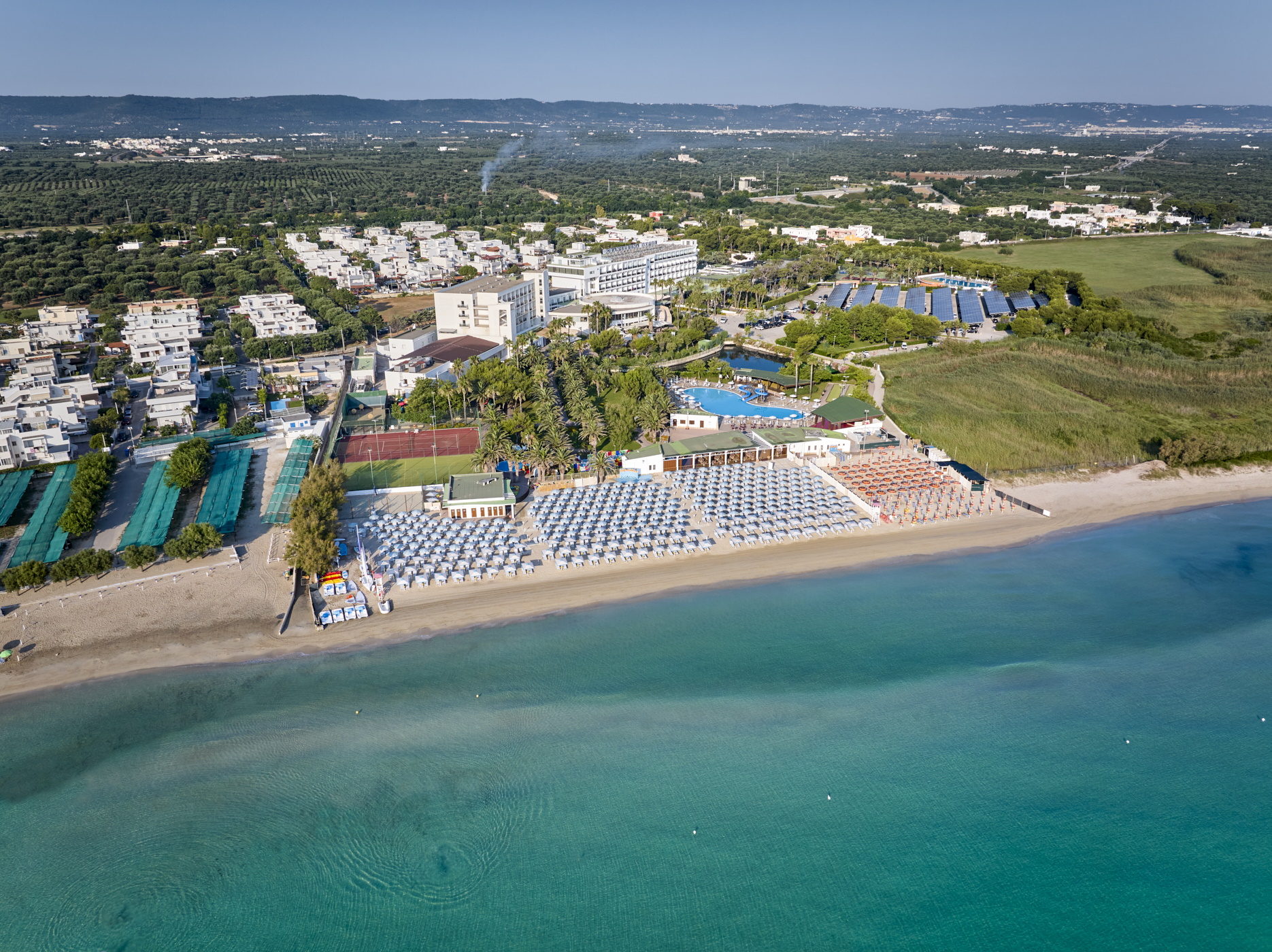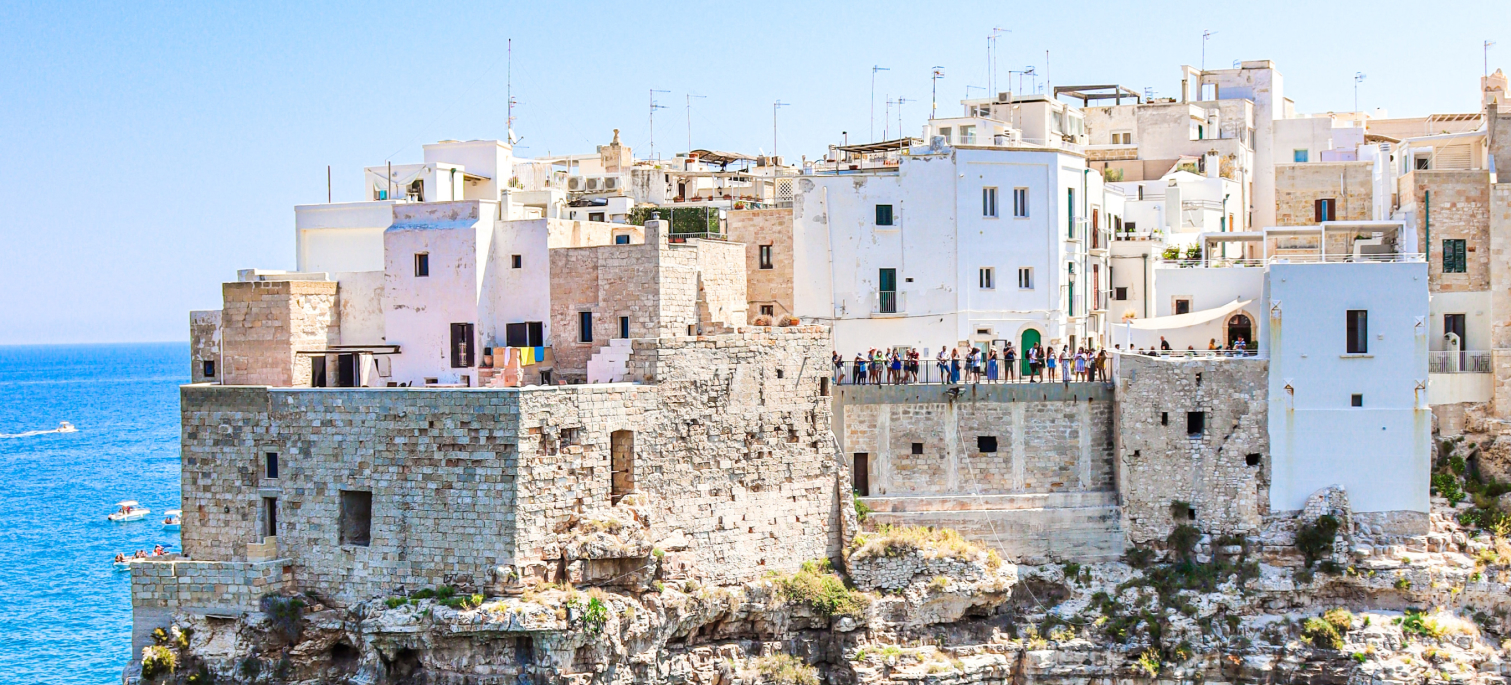

Located in Torre Canne di Fasano, GranSerena Hotel harmoniously blends the beauty of nature with modern comfort and a recently renovated design for a holiday you won’t forget.


With its Adriatic and Ionian coastlines, Puglia is famous for its golden beaches, spectacular cliffs, and tempting crystal-clear water. The beaches of Castellaneta Marina, Marina di Ginosa, and Torre Canne, which earned a Blue Flag in 2025, are among the dreamiest.
But there’s more to Puglia than the sea. Located in the heart of the Mediterranean, the captivating region’s irresistible mix of history, breathtaking landscapes, and authenticity lures travellers from near and far. Its hinterland boasts centuries-old olive groves, trulli, white towns, and a wealth of food and wine traditions that win over the palate and the heart of anyone who visits. ri, i caratteristici trulli, le città bianche e la ricchezza di tradizioni enogastronomiche che conquistano il palato e il cuore di chiunque vi ponga piede.
Distance 90 km – Just 17 kilometres from the city of Andria, Castel del Monte is Frederick II of Swabia’s 13th-century fortress, one of Puglia’s top tourist destinations. The imposing, impressive structure has an original octagonal shape that recurs throughout the structure, both in the courtyard and in various architectural elements, such as the eight towers. The shape and location correspond to the direction of the shadows during the solstice and equinox. The evocative decorative elements, such as the two crouching lions on either side of the entrance gate, are imbued with symbolism that combines elements of classical antiquity and Nordic and Islamic culture.
Distance 50 km – The landscape of Matera embodies the contrast between the ancient and the modern, tradition and innovation. A UNESCO World Heritage Site since 1993, Matera is known worldwide as the city of the Sassi or the Underground City. Matera is not only the oldest inhabited nucleus in Basilicata and Southern Italy but is also among the world’s ten oldest inhabited cities, with settlements dating back some 10,000 years. The cave dwellings carved into the mountain were continuously inhabited from the Bronze Age until 1952, when a national law called for the forced eviction of approximately 15,000 residents. In addition to lodging museums, they’re the setting for several national and international cultural events today, leading to Matera’s designation as the 2019 European Capital of Culture.
Distance 100 km – Lecce lies in the heart of Salento between the Adriatic and Ionian Seas. It’s known for its Baroque splendour, evident in churches, palaces, and architectural details, which earned the city its nickname: “Florence of the South”. The rich, crumbly Lecce stone gives life to fine details, such as those that adorn the Basilica of Santa Croce and the Seminary building, or the magnificent Piazza del Duomo with the Cathedral of Maria Santissima Assunta. The Salento, nestled between the Adriatic and Ionian Seas, offers rocky, rugged coastlines on one side and vast sandy stretches on the other, converging in the enchanting Santa Maria di Leuca. The landscape is dotted with dry stone walls, olive trees, dolmens, and ancient farmhouses, each corner whispering tales of the past. Every year, events such as the Notte della Taranta celebrate the region’s musical heritage, blending the rhythms of the Salento pizzica with modern influences, creating an unforgettable fusion of tradition and contemporary energy.
Distance: 27 km – Ostuni, the White City of Brindisi, is like a living nativity, its whitewashed walls glowing beneath the sky, surrounded by olive trees and dry stone walls, where the eye can travel all the way to the Mediterranean. Nestled between the Valle d’Itria and Alto Salento, it lies in a captivating region, renowned for its crystal-clear waters, high-quality services, awarded the Blue Flag and five sails by Legambiente, as well as its precious historical and cultural treasures.
The contrast between modernity and tradition, a distinct feature of southern Italy, is essential to Puglia’s charm–the new blends into settings where time seems to stand still. Alberobello, a UNESCO World Heritage Site in the Bari province, exemplifies this. The unique jumble of 1,500 Trulli is in the Monti and Aja Piccola districts, and its historic centre consists exclusively of these conical-shaped structures made from Murge plateau limestone and assembled from dry stone. The Trulli, found mainly in the Itria Valley between the provinces of Bari and Brindisi, have prehistoric origins and are still inhabited today.
Locorotondo is a hamlet of tightly packed white houses that form a circle in the heart of the picturesque Itria Valley. The distinct layout dates back to the year 1000 and distinguishes Locorotondo’s charming historic centre. Church steeples rise over the whitewashed houses, evidence of the deep spirituality that permeates local culture and history.
Martina Franca, on the Murgia’s eastern hills in the heart of the Itria Valley, rises majestically between the Ionian and Adriatic seas. It’s surrounded by a fascinating naturalistic landscape with the Bosco delle Pianelle Oriented Regional Nature Reserve replete with biodiversity and scenic trails. Winding alleys weave through the old town and its Baroque palaces, vertical white houses, and majestic churches displaying incredible artwork.
The landscape of Valle d’Itria is dominated by vineyards and olive groves, by dry stone walls and red earth, punctuated by the white of the Trulli that occasionally rise in the countryside. Puglia offers unique scenery, with its olive-covered hills plunging into the blue Adriatic Sea, with its villages rich in history and tradition, animated by narrow alleys, charming white houses, shady little squares and where old shops and restaurants spread the flavours and aromas of the region.
THE UNIQUE ARCHITECTURE OF FREDERICO II’S CASTLE, A UNESCO HERITAGE SITE
Distance 90 km – Just 17 kilometres from the city of Andria, Castel del Monte is Frederick II of Swabia’s 13th-century fortress, one of Puglia’s top tourist destinations. The imposing, impressive structure has an original octagonal shape that recurs throughout the structure, both in the courtyard and in various architectural elements, such as the eight towers. The shape and location correspond to the direction of the shadows during the solstice and equinox. The evocative decorative elements, such as the two crouching lions on either side of the entrance gate, are imbued with symbolism that combines elements of classical antiquity and Nordic and Islamic culture.
THE CITY OF THE SASSI, A UNESCO WORLD HERITAGE SITE AND EUROPEAN CAPITAL OF CULTURE FOR 2019
Distance 50 km – The landscape of Matera embodies the contrast between the ancient and the modern, tradition and innovation. A UNESCO World Heritage Site since 1993, Matera is known worldwide as the city of the Sassi or the Underground City. Matera is not only the oldest inhabited nucleus in Basilicata and Southern Italy but is also among the world’s ten oldest inhabited cities, with settlements dating back some 10,000 years. The cave dwellings carved into the mountain were continuously inhabited from the Bronze Age until 1952, when a national law called for the forced eviction of approximately 15,000 residents. In addition to lodging museums, they’re the setting for several national and international cultural events today, leading to Matera’s designation as the 2019 European Capital of Culture.
PUGLIA’S BAROQUE CAPITAL
Distance 100 km – Lecce lies in the heart of Salento between the Adriatic and Ionian Seas. It’s known for its Baroque splendour, evident in churches, palaces, and architectural details, which earned the city its nickname: “Florence of the South”. The rich, crumbly Lecce stone gives life to fine details, such as those that adorn the Basilica of Santa Croce and the Seminary building, or the magnificent Piazza del Duomo with the Cathedral of Maria Santissima Assunta.
The Salento, nestled between the Adriatic and Ionian Seas, offers rocky, rugged coastlines on one side and vast sandy stretches on the other, converging in the enchanting Santa Maria di Leuca.
The landscape is dotted with dry stone walls, olive trees, dolmens, and ancient farmhouses, each corner whispering tales of the past. Every year, events such as the Notte della Taranta celebrate the region’s musical heritage, blending the rhythms of the Salento pizzica with modern influences, creating an unforgettable fusion of tradition and contemporary energy.
THE WHITE CITY
Distance: 27 km – Ostuni, the White City of Brindisi, is like a living nativity, its whitewashed walls glowing beneath the sky, surrounded by olive trees and dry stone walls, where the eye can travel all the way to the Mediterranean. Nestled between the Valle d’Itria and Alto Salento, it lies in a captivating region, renowned for its crystal-clear waters, high-quality services, awarded the Blue Flag and five sails by Legambiente, as well as its precious historical and cultural treasures.
A route among Trulli in the magnificent Pugliese countryside
The contrast between modernity and tradition, a distinct feature of southern Italy, is essential to Puglia’s charm–the new blends into settings where time seems to stand still. Alberobello, a UNESCO World Heritage Site in the Bari province, exemplifies this. The unique jumble of 1,500 Trulli is in the Monti and Aja Piccola districts, and its historic centre consists exclusively of these conical-shaped structures made from Murge plateau limestone and assembled from dry stone. The Trulli, found mainly in the Itria Valley between the provinces of Bari and Brindisi, have prehistoric origins and are still inhabited today.
The tradition of a unique village
Locorotondo is a hamlet of tightly packed white houses that form a circle in the heart of the picturesque Itria Valley. The distinct layout dates back to the year 1000 and distinguishes Locorotondo’s charming historic centre. Church steeples rise over the whitewashed houses, evidence of the deep spirituality that permeates local culture and history.
Art and breathtaking views in the heart of the Itria Valley
Martina Franca, on the Murgia’s eastern hills in the heart of the Itria Valley, rises majestically between the Ionian and Adriatic seas. It’s surrounded by a fascinating naturalistic landscape with the Bosco delle Pianelle Oriented Regional Nature Reserve replete with biodiversity and scenic trails. Winding alleys weave through the old town and its Baroque palaces, vertical white houses, and majestic churches displaying incredible artwork.
Nature, beauty and unique views
The landscape of Valle d’Itria is dominated by vineyards and olive groves, by dry stone walls and red earth, punctuated by the white of the Trulli that occasionally rise in the countryside.
Puglia offers unique scenery, with its olive-covered hills plunging into the blue Adriatic Sea, with its villages rich in history and tradition, animated by narrow alleys, charming white houses, shady little squares and where old shops and restaurants spread the flavours and aromas of the region.
Enter the world of Bluserena. Sign up to receive email updates
on news, stories, and great holiday deals.